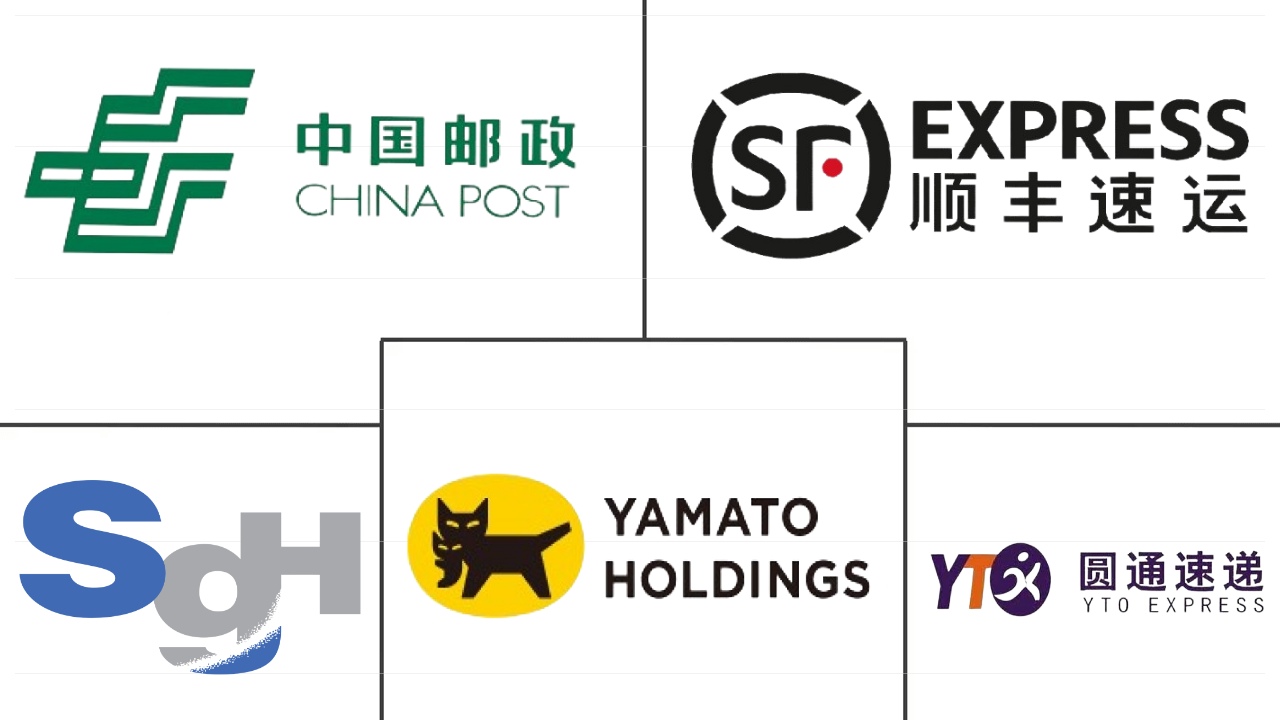Market Size of asia pacific domestic courier Industry
|
|
Study Period | 2017 - 2030 |
|
|
Market Size (2024) | USD 145.71 Billion |
|
|
Market Size (2030) | USD 216.01 Billion |
|
|
Largest Share by End User Industry | E-Commerce |
|
|
CAGR (2024 - 2030) | 6.78 % |
|
|
Largest Share by Country | China |
Major Players |
||

|
||
|
*Disclaimer: Major Players sorted in no particular order |
Asia Pacific Domestic Courier Market Analysis
The Asia Pacific Domestic Courier Market size is estimated at 145.71 billion USD in 2024, and is expected to reach 216.01 billion USD by 2030, growing at a CAGR of 6.78% during the forecast period (2024-2030).
145.71 Billion
Market Size in 2024 (USD)
216.01 Billion
Market Size in 2030 (USD)
5.61 %
CAGR (2017-2023)
6.78 %
CAGR (2024-2030)
Fastest Growing Market by End User Industry
7.42 %
Projected CAGR, E-Commerce, 2024-2030
E-commerce, which is generating courier and parcel delivery demand, is rapidly expanding as major players are capitalizing on increased urbanization and the adoption of digitalization.
Fastest Growing Market by Shipment Weight
7.29 %
Projected CAGR, Light Weight Shipments, 2024-2030
The delivery of goods like fashion apparel in China and medicines in India is driving the demand for delivery services in the region.
Largest Market by Shipment Weight
55.79 %
value share, Light Weight Shipments, 2023
The delivery of goods like fashion and apparel products, medicines, and groceries is significantly generating demand for courier delivery services in the region.
Largest Market by End User Industry
34.26 %
value share, E-Commerce, 2023
E-commerce players, which generate significant courier delivery demand, are expanding partnerships with courier companies to cater to increasing demand and returning goods.
First leading Market player
13 %
market share, SF Express (KEX-SF), 2022

SF Express offers domestic courier services, including door-to-door delivery services in major cities within Asia-Pacific.
Partnerships between courier companies and e-commerce players are increasing in the region to provide better services
- Domestic courier services are becoming increasingly important in the e-commerce industry. The pandemic brought about a drastic change in shopping behavior over the past years, shifting the shopping process worldwide toward online shopping. Partnerships between courier companies and e-commerce players are increasing in the region. For instance, in March 2022, Delhivery.com, a logistics and supply chain company, announced a partnership with Ajio.com, an e-commerce company. The partnership was made to address the issue of low-quality returned items and ensure that they are reinvented for sale.
- Retailers in the region are providing domestic courier services using micro-fulfillment centers. Out-of-home (OOH) delivery has been gaining popularity across the region. For instance, in China, 60% of parcels are currently delivered on the same day using micro-fulfillment centers in cities across the country to keep up with consumer expectations. China has the biggest OOH delivery market in the world, with hundreds of thousands of locker locations, growing at a rate of 25% per year.
- The growth of domestic courier services for medical devices in the Asia-Pacific region is driven by a combination of increasing demand for healthcare services, advancements in logistics technology, and the growth of healthcare e-commerce. In addition, India, China, and Japan have established their footholds in the region, accounting for 85% of the total medical device market. Courier companies are expanding in Asia-Pacific to provide courier services for healthcare products. For instance, in April 2023, JD Logistics took a significant step toward transforming the healthcare industry in China by integrating express delivery services with Guang’anmen Hospital (GAMH).
Australian grocery home delivery market hit USD 8.25 billion in 2023 as rise in internet user penetration
- In China 2021, about 60% of parcels were delivered on the same day, with JD.com fulfilling 80% of these deliveries. Other major players in same-day delivery include Alibaba and SF Express. These companies have 50-100 service centers to facilitate domestic same-day deliveries, which are quick to deploy and require minor investments. The rise of Q-commerce, focusing on quality, efficiency, and affordability for deliveries within hours of ordering, drives the demand for same-day deliveries. By 2026, the number of quick commerce orders is projected to reach 95 billion, mainly driven by the increasing demand for online food and beverages, valued at USD 151 billion in 2022.
- In the Australian domestic courier, express, and parcel (CEP) market, grocery home delivery drives significant revenue growth, and it is projected to reach a value of USD 8.25 billion in 2023 compared to USD 7.09 billion in 2022. The total grocery market was valued at USD 125 billion in 2022. The user penetration for grocery delivery is expected to reach 29.4% in 2023, with an estimated 9.97 million users by 2027. Consumer preferences for economical and convenient grocery home delivery options fuel this growth.
- In 2022, India Post introduced same-day delivery in five cities in Gujarat, while Amazon India launched same-day deliveries within hours for Prime customers in over 50 cities. Similarly, Indonesia is experiencing investment and expansion of same-day delivery services, with a last-mile logistics company receiving USD 3.25 million in funding in 2021. According to the company, this investment primarily focuses on the Indonesian same-day delivery market, which is projected to grow by 30% in 2023.
Asia Pacific Domestic Courier Industry Segmentation
Express, Non-Express are covered as segments by Speed Of Delivery. Heavy Weight Shipments, Light Weight Shipments, Medium Weight Shipments are covered as segments by Shipment Weight. E-Commerce, Financial Services (BFSI), Healthcare, Manufacturing, Primary Industry, Wholesale and Retail Trade (Offline), Others are covered as segments by End User Industry. Business-to-Business (B2B), Business-to-Consumer (B2C), Consumer-to-Consumer (C2C) are covered as segments by Model. Australia, China, India, Indonesia, Japan, Malaysia, Pakistan, Philippines, Thailand, Vietnam are covered as segments by Country.
- Domestic courier services are becoming increasingly important in the e-commerce industry. The pandemic brought about a drastic change in shopping behavior over the past years, shifting the shopping process worldwide toward online shopping. Partnerships between courier companies and e-commerce players are increasing in the region. For instance, in March 2022, Delhivery.com, a logistics and supply chain company, announced a partnership with Ajio.com, an e-commerce company. The partnership was made to address the issue of low-quality returned items and ensure that they are reinvented for sale.
- Retailers in the region are providing domestic courier services using micro-fulfillment centers. Out-of-home (OOH) delivery has been gaining popularity across the region. For instance, in China, 60% of parcels are currently delivered on the same day using micro-fulfillment centers in cities across the country to keep up with consumer expectations. China has the biggest OOH delivery market in the world, with hundreds of thousands of locker locations, growing at a rate of 25% per year.
- The growth of domestic courier services for medical devices in the Asia-Pacific region is driven by a combination of increasing demand for healthcare services, advancements in logistics technology, and the growth of healthcare e-commerce. In addition, India, China, and Japan have established their footholds in the region, accounting for 85% of the total medical device market. Courier companies are expanding in Asia-Pacific to provide courier services for healthcare products. For instance, in April 2023, JD Logistics took a significant step toward transforming the healthcare industry in China by integrating express delivery services with Guang’anmen Hospital (GAMH).
| Speed Of Delivery | |
| Express | |
| Non-Express |
| Shipment Weight | |
| Heavy Weight Shipments | |
| Light Weight Shipments | |
| Medium Weight Shipments |
| End User Industry | |
| E-Commerce | |
| Financial Services (BFSI) | |
| Healthcare | |
| Manufacturing | |
| Primary Industry | |
| Wholesale and Retail Trade (Offline) | |
| Others |
| Model | |
| Business-to-Business (B2B) | |
| Business-to-Consumer (B2C) | |
| Consumer-to-Consumer (C2C) |
| Country | |
| Australia | |
| China | |
| India | |
| Indonesia | |
| Japan | |
| Malaysia | |
| Pakistan | |
| Philippines | |
| Thailand | |
| Vietnam | |
| Rest of Asia Pacific |
Asia Pacific Domestic Courier Market Size Summary
The Asia Pacific Domestic Courier Market is experiencing significant growth, driven by the increasing importance of courier services in the burgeoning e-commerce sector. The shift towards online shopping, accelerated by the pandemic, has led to a surge in demand for efficient domestic courier services. This has resulted in numerous partnerships between courier companies and e-commerce platforms, enhancing service quality and addressing challenges such as product returns. The region is witnessing a rise in out-of-home delivery solutions, particularly in China, where same-day delivery is becoming the norm. The integration of micro-fulfillment centers is further boosting the efficiency of parcel deliveries, meeting the high consumer expectations for rapid service. Additionally, the market is seeing expansion in the healthcare sector, with courier services playing a crucial role in the distribution of medical devices, supported by advancements in logistics technology and the growth of healthcare e-commerce.
The market landscape is characterized by a fragmented structure, with major players like China Post, SF Express, SG Holdings Co., Ltd., Yamato Holdings, and YTO Express holding significant shares. These companies are actively investing in innovative solutions, such as AI-driven delivery systems, to enhance their operational capabilities. The Australian market is also witnessing growth, particularly in grocery home delivery services, driven by consumer preferences for convenient and cost-effective options. Meanwhile, the region's logistics and warehousing sector is undergoing transformation, with increased mergers and acquisitions focusing on innovation and sustainability. The Asia Pacific region's strategic importance is underscored by its role in global freight transport, with significant contributions to surface freight flows and international trade. As the market continues to evolve, the focus on quick commerce and same-day delivery services is expected to drive further growth, catering to the rising demand for rapid and efficient delivery solutions across the region.
Asia Pacific Domestic Courier Market Size - Table of Contents
-
1. MARKET SEGMENTATION (includes Market Value in USD, Forecasts up to 2030 and analysis of growth prospects)
-
1.1 Speed Of Delivery
-
1.1.1 Express
-
1.1.2 Non-Express
-
-
1.2 Shipment Weight
-
1.2.1 Heavy Weight Shipments
-
1.2.2 Light Weight Shipments
-
1.2.3 Medium Weight Shipments
-
-
1.3 End User Industry
-
1.3.1 E-Commerce
-
1.3.2 Financial Services (BFSI)
-
1.3.3 Healthcare
-
1.3.4 Manufacturing
-
1.3.5 Primary Industry
-
1.3.6 Wholesale and Retail Trade (Offline)
-
1.3.7 Others
-
-
1.4 Model
-
1.4.1 Business-to-Business (B2B)
-
1.4.2 Business-to-Consumer (B2C)
-
1.4.3 Consumer-to-Consumer (C2C)
-
-
1.5 Country
-
1.5.1 Australia
-
1.5.2 China
-
1.5.3 India
-
1.5.4 Indonesia
-
1.5.5 Japan
-
1.5.6 Malaysia
-
1.5.7 Pakistan
-
1.5.8 Philippines
-
1.5.9 Thailand
-
1.5.10 Vietnam
-
1.5.11 Rest of Asia Pacific
-
-
Asia Pacific Domestic Courier Market Size FAQs
How big is the Asia Pacific Domestic Courier Market?
The Asia Pacific Domestic Courier Market size is expected to reach USD 145.71 billion in 2024 and grow at a CAGR of 6.78% to reach USD 216.01 billion by 2030.
What is the current Asia Pacific Domestic Courier Market size?
In 2024, the Asia Pacific Domestic Courier Market size is expected to reach USD 145.71 billion.

